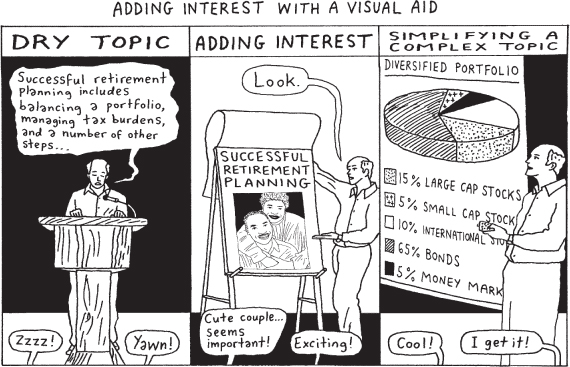WHY USE PRESENTATION AIDS?
Printed Page 404
Speech communication experts have long believed that listeners are much more likely to grasp spoken facts and concepts if presenters also provide visual and other nonverbal cues.1 Indeed, as early as the 1950s, studies showed that the use of audio and visual aids in a speech could increase learning by as much as 55 percent.2 A presentation aid is anything beyond your spoken words that you employ to help your audience members understand and remember your message. Also known as audiovisual aids, presentation aids include any materials you might use to support and convey the points and subpoints in your speech.
Consider your own learning experiences over the years. For example, how did you come to understand difficult math concepts? Did your teacher expect you to know how to solve complex problems after merely lecturing to you about algebra or geometry? Or did she illustrate the problems and concepts on the chalkboard—with plenty of examples? Most likely, you found the illustrations helpful and even essential for grasping the concepts. Likewise, if you studied a language not native to you, did your teacher merely lecture to you about the language in your native tongue? Or did he model the language for you, demonstrating correct pronunciation and perhaps playing recordings of native speakers using the language? Again, you probably found the demonstrations and recordings crucial for mastering the basics of the new language.
Savvy use of presentation aids can help you gain several important advantages as you deliver a speech.
Presentation Aids Can Make Your Speech More Interesting. A colorful and attractive presentation aid can help you spice up any presentation, especially one on a slightly dry topic. For instance, a financial-services salesperson giving a talk on retirement savings might display a photo of an older couple looking relaxed, happy, and healthy. The salesperson could also provide graphs that show the makeup of sensible investments.

Presentation Aids Can Simplify a Complex Topic. If you are giving a speech on a technical or complicated topic, a presentation aid can help you simplify your message so that your listeners can better understand you. For example, a student giving a presentation on how to skydive could show a drawing of a simplified parachute, with labels highlighting each part of the equipment.
Presentation Aids Can Help Your Audience Remember Your Speech. Many individuals find visual information much easier to recall than spoken information.3 Thus, the right presentation aids can help ensure that you leave a lasting impression on your listeners. For example, a speaker sharing a lengthy list of reasons for changing the entrance requirements at a community college might hammer home his message by displaying a bulleted list of his main points at the end of his speech.
